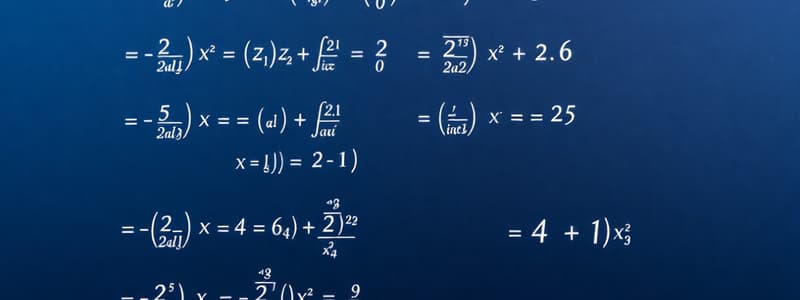Podcast
Questions and Answers
What is the quadratic formula used to solve equations of the form ax² + bx + c = 0?
What is the quadratic formula used to solve equations of the form ax² + bx + c = 0?
- x = (b ± √(b² + 4ac)) / 2a
- x = (b ± √(4ac - b²)) / 2a
- x = (-b ± √(b² + 4ac)) / 2a
- x = (-b ± √(b² - 4ac)) / 2a (correct)
If the discriminant (Δ) of a quadratic equation is less than 0, then there are two distinct real roots.
If the discriminant (Δ) of a quadratic equation is less than 0, then there are two distinct real roots.
False (B)
What are the roots of the quadratic equation x² + 5x + 6 = 0?
What are the roots of the quadratic equation x² + 5x + 6 = 0?
x = -2 or x = -3
The part of the quadratic formula under the square root is called the ______.
The part of the quadratic formula under the square root is called the ______.
Match the following properties of quadratic equations with their descriptions:
Match the following properties of quadratic equations with their descriptions:
What is the result of solving the inequality $2x + 3 < 7$?
What is the result of solving the inequality $2x + 3 < 7$?
When multiplying or dividing both sides of an inequality by a negative number, the inequality sign remains the same.
When multiplying or dividing both sides of an inequality by a negative number, the inequality sign remains the same.
What is the primary purpose of function notation like f(x)?
What is the primary purpose of function notation like f(x)?
The critical points for the quadratic inequality $x² - x - 6 ≥ 0$ are at $x = ______ and $x = ______.
The critical points for the quadratic inequality $x² - x - 6 ≥ 0$ are at $x = ______ and $x = ______.
Match the following types of functions with their descriptions:
Match the following types of functions with their descriptions:
Which of these inequalities represents a solution where x is less than or equal to -2 or greater than or equal to 3?
Which of these inequalities represents a solution where x is less than or equal to -2 or greater than or equal to 3?
The domain of a function is defined as the set of all possible output values.
The domain of a function is defined as the set of all possible output values.
What does the vertex of a parabola represent when a > 0?
What does the vertex of a parabola represent when a > 0?
The roots of a quadratic equation can be found using synthetic division.
The roots of a quadratic equation can be found using synthetic division.
What is the general form of a polynomial?
What is the general form of a polynomial?
The axis of symmetry of a parabola is a vertical line that passes through the __________.
The axis of symmetry of a parabola is a vertical line that passes through the __________.
Match the following terms related to polynomials with their definitions:
Match the following terms related to polynomials with their definitions:
In the example f(x) = x² - 4x + 3, what are the roots of the function?
In the example f(x) = x² - 4x + 3, what are the roots of the function?
A polynomial function can model the growth of a population over time.
A polynomial function can model the growth of a population over time.
In the quadratic equation ax² + bx + c = 0, if a < 0, the parabola __________.
In the quadratic equation ax² + bx + c = 0, if a < 0, the parabola __________.
Flashcards
Factoring Quadratic Equations
Factoring Quadratic Equations
A method to solve quadratic equations by expressing the equation as a product of two linear factors. For example, if the quadratic equation is (x + 2)(x + 3) = 0, then the solutions are x = -2 and x = -3.
Quadratic Formula
Quadratic Formula
A powerful tool for solving quadratic equations in the form ax² + bx + c = 0. It provides solutions for x, whether the equation is factorable or not.
The Discriminant (Δ)
The Discriminant (Δ)
The part of the quadratic formula under the square root, represented as Δ = b² - 4ac, provides insights into the nature of the solutions (roots) of the equation.
Quadratic Function
Quadratic Function
Signup and view all the flashcards
Completing the Square
Completing the Square
Signup and view all the flashcards
Roots of a quadratic equation
Roots of a quadratic equation
Signup and view all the flashcards
Vertex of a parabola
Vertex of a parabola
Signup and view all the flashcards
Axis of symmetry of a parabola
Axis of symmetry of a parabola
Signup and view all the flashcards
Polynomial
Polynomial
Signup and view all the flashcards
Roots of a polynomial
Roots of a polynomial
Signup and view all the flashcards
Degree of a polynomial
Degree of a polynomial
Signup and view all the flashcards
What is an inequality?
What is an inequality?
Signup and view all the flashcards
How do you solve inequalities?
How do you solve inequalities?
Signup and view all the flashcards
How to visually represent inequality solutions?
How to visually represent inequality solutions?
Signup and view all the flashcards
What is a function in mathematics?
What is a function in mathematics?
Signup and view all the flashcards
What are different types of functions?
What are different types of functions?
Signup and view all the flashcards
What is function notation?
What is function notation?
Signup and view all the flashcards
What is the domain and range of a function?
What is the domain and range of a function?
Signup and view all the flashcards
Study Notes
Advanced Algebra: Diving Deeper into Mathematical Relationships
- Advanced Algebra builds upon basic algebra, exploring more complex concepts and real-world applications.
- Key concepts include quadratic equations and functions, polynomials, inequalities, and functions.
Quadratic Equations and Functions
- Quadratic equations are in the form ax² + bx + c = 0.
- Solving quadratic equations:
- Factoring: Finding factors to solve (e.g., x² + 5x + 6 = 0 factors to (x + 2)(x + 3) = 0, so x = -2 or x = -3).
- Completing the square: A method to rewrite the equation in a perfect square form.
- Quadratic formula: A formula that always works to find the solutions: x = (-b ± √(b² - 4ac)) / 2a.
- Discriminant (b² - 4ac): Indicates the nature of the roots:
- Positive: Two distinct real roots
- Zero: One real repeated root
- Negative: Two complex roots
- Quadratic functions: Equations of the form f(x) = ax² + bx + c, graphed as parabolas.
- Roots are the x-intercepts.
- The vertex represents the maximum or minimum value.
- The axis of symmetry is a vertical line through the vertex.
Polynomials
- Polynomials are expressions with variables raised to non-negative integer powers.
- Operations with polynomials: Adding, subtracting, multiplying, and dividing.
- Finding roots of polynomials: Finding values of x that make the polynomial equal to zero. Methods include factoring, the Rational Root Theorem, and synthetic division.
Inequalities
- Inequalities compare expressions using <, >, ≤, or ≥.
- Solving inequalities is similar to solving equations, but dividing or multiplying by a negative reverses the inequality sign.
- Graphical interpretation: Solutions are regions on the number line or coordinate plane.
Functions
- Functions relate inputs to outputs (each input has one output).
- Types of functions include linear, quadratic, polynomial, exponential, logarithmic, and trigonometric.
- Function notation: f(x) represents the output of function f when the input is x.
- Domain: Possible input values
- Range: Possible output values
- Transformations of functions: Shifts, stretches, and reflections affect the graph. Example shifts up, down, left, or right.
- Graphs visually represent relationships between inputs and outputs. Key features include intercepts, vertices, and asymptotes.
Studying That Suits You
Use AI to generate personalized quizzes and flashcards to suit your learning preferences.
Related Documents
Description
Test your knowledge on quadratic equations and functions in this Advanced Algebra quiz. Explore various methods of solving quadratic equations, including factoring, completing the square, and using the quadratic formula. Understand the discriminant's role in determining the nature of the roots.




